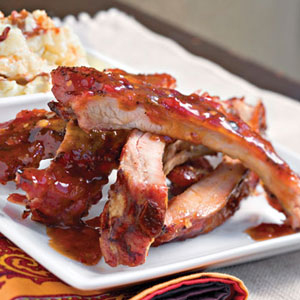
The Curious Cook - Leave the Barbecued Ribs to the Professionals - NYTimes.com
EVERYONE knows the barbecue mantra "low and slow:" cook tough cuts of meat over low indirect heat for hours and hours until they fall off the bone and melt in the mouth.To be precise, don't cook ribs for more than a couple of people on a standard-size domestic grill.It takes about five pounds of ribs to feed four people generously. That turns out to be a couple hundred square inches of ribs.My starter-model gas grill is about 275 square inches, with heating elements running along the long sides. Ribs for four cover most of the grill surface, and some of them lie directly over the heating element.Ribs for four cover more than half its area, so that some of the meat ends up within a few inches of the coals.Meanwhile, the bottom surface of the meat is exposed to hotter air, and on a crowded grill, parts are exposed to the direct heat of the flames or coals. So even if we follow the recipe exactly and the grill thermometer never rises above 200 degrees, some of the meat is being cooked at a much higher temperature and will dry out and toughen.On a gas grill, where the heating elements are fixed in place right under the cooking surface, the only practical solution is to turn on the heat on one half of the grill, and cook only as much meat as will fit on the other side. It's deeper, so you can keep the coals farther from the cooking surface, and protect the meat from their direct heat by propping up a foil heat shield.It's much easier to barbecue well in a smoker, a kind of cooker that's specifically designed to provide low indirect heat, or on a large grill that can keep all the meat a good eight inches or more from the heat. But because I barbecue only occasionally and don't plan to upgrade my basic grills anytime soon, I've settled on a hybrid approach to ribs. I cook them low and slow in the oven and then give them a brief finishing hit of high heat or smoke on the grill.There's nothing new about cooking ribs in the oven, but here, too, recipes are often short on details that make a difference.We cook ribs and other typical barbecue cuts at a low temperature to conserve as much of the meat's moisture as possible, and we cook them for hours to dissolve their tough connective tissue into succulent gelatin.You can get very juicy ribs by cooking them at 135 degrees, but making them tender takes two or three days. At 160 degrees, you get tender ribs in 10 to 12 hours. At 170 to 180 degrees, the meat is noticeably dryer, but the cooking time is a more manageable 6 to 8 hours.I start cooking ribs in the oven at around 200 degrees if they're wrapped in foil, and unwrapped ribs at 225 degrees to compensate for the cooling effect of evaporation from the exposed meat surface.I season the meat simply.Of course, barbecuing for company is about much more than the meat. The kitchen can't match the outdoors for celebrating the pleasures of summer, and dry ribs can still be tasty. But to get the best from your grill, study it and see how much meat it can actually heat gently and evenly.Then when you sit down and it's the meat that matters, see which ribs disappear first.
full article by Harold McGee http://www.nytimes.com/2010/06/30/dining/30curious.html?ref=dining&_r=0
Hiç yorum yok:
Yorum Gönder